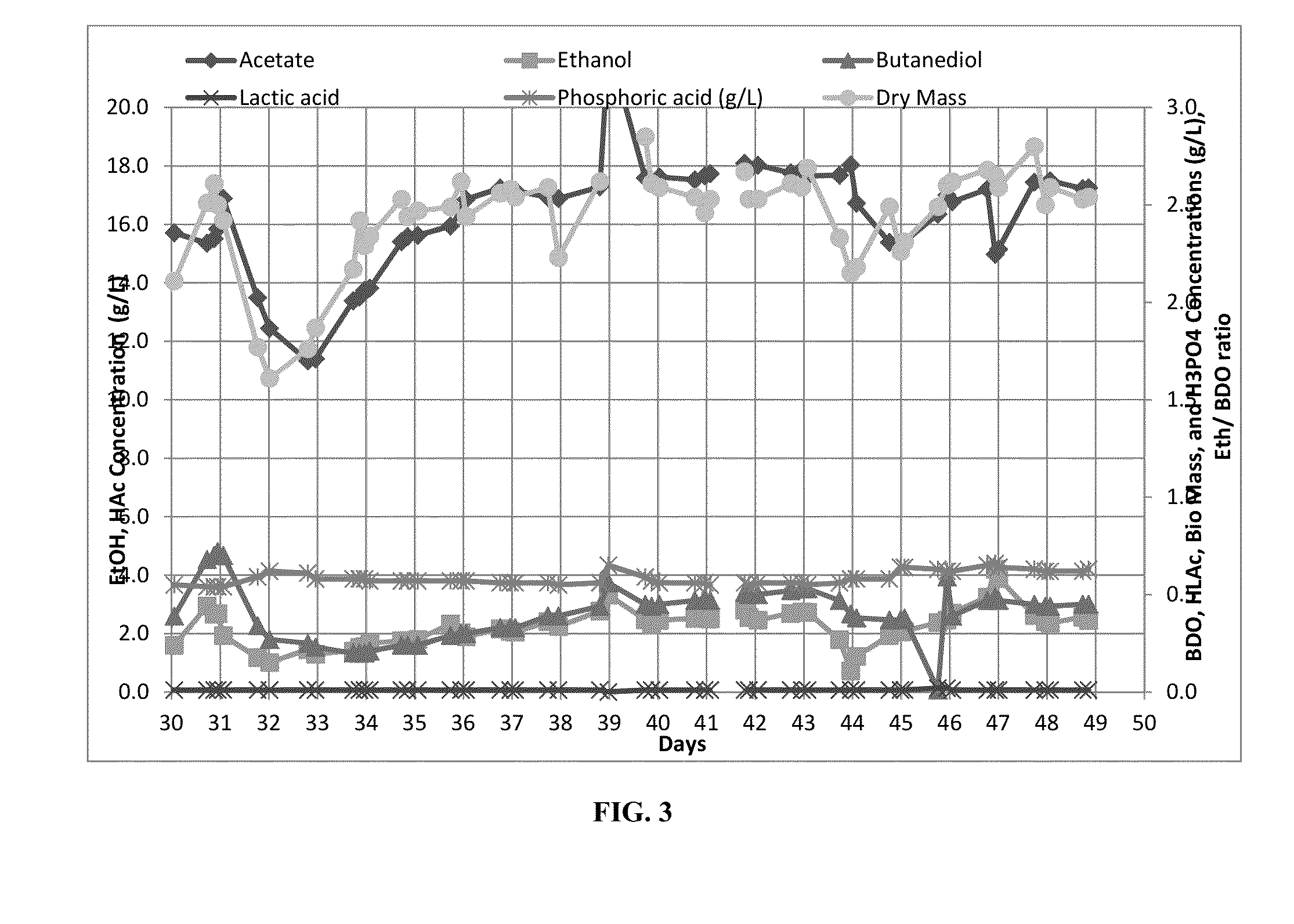Fermentation process
a fermentation process and technology of lipids, applied in the field of fermentation process, can solve the problems of inability to meet the economic sustainability of all geographies, the cultivation of starch or sucrose-producing crops for ethanol production, and the significant challenges of generation feedstocks, etc., to achieve the effect of increasing the production of lipids in the secondary bioreactor
- Summary
- Abstract
- Description
- Claims
- Application Information
AI Technical Summary
Benefits of technology
Problems solved by technology
Method used
Image
Examples
example 1
Fermentation of CO in Bioreactor to Produce Acetate
[0158]A glycerol stock of a Clostridium autoethanogenum was revived in serum bottles. The glycerol stock stored at 80° C. was slowly thawed and transferred into the serum bottle using a syringe. This process was carried out inside an anaerobic chamber. The inoculated serum bottle was subsequently removed from the anaerobic chamber and pressurized to a total of 45 psi using a CO-containing gas mixture (40% CO, 3% H2, 21% CO2, 36% N2). The bottle was then placed horizontally on a shaker inside an incubator at a temperature of 37 C. After two days of incubation and after verifying that the culture grew, the bottle was used to inoculate another set of eight gas containing serum bottles with 5˜mL of this culture. These serum bottles were incubated for another day as described above and then used to inoculate 5 L of liquid medium that was prepared in a 10 L CSTR. The initial CO containing gas flow was set at 100˜mL / min and the stirring ra...
example 2
Fermentation of CO2 and H2 in Bioreactor to Produce Acetate
[0160]Media at pH 6.5 was prepared as using the protocol defined by Balch et al (See, e.g., Balch et al, (1977) International Journal of Systemic Bacteriology., 27:355-361). A three-litre reactor was filled with 1500 ml of the media. Oxygen was removed from the media by continuously sparging with N2. The gas was switched from N2 to a mixture of 60% H2, 20% CO2, and 20% N2 30 minutes before inoculation. The inoculum (150 ml) came from a continuous Acetobacterium woodii culture fed with the same gas mixture. The bioreactor was maintained at 30° C. and stirred at 200 rpm at the time of inoculation. During the following batch growth phase, agitation was increased incrementally to 600 rpm. The gas flow was increased incrementally by 50 ml / min according to the dropping H2 / CO2 in the headspace as a result of the increasing biomass. To compensate for the acetic acid produced, the pH was automatically controlled to 7 using 5 M NaOH. ...
example 3
Methods and Materials
[0163]Bacteria:
[0164]Oleaginous yeast Cryptococcus curvatus DSM 721 was revived in media containing glucose 10 g / L, yeast extract 1 g / L, and peptone 1 g / L.[0165]1. The cultures were inoculated into permeate from an Acetobacterium woodii process. Cultures were fermented in a conical flask (50 ml of media in 250 ml flask) and at 25°c and pH 7. C. curvatus grew in the permeate from the A. woodii process and converted all the acetic acid present in the permeate to biomass. The pH of culture increased from 7 to 9.3 in the culture.[0166]2. A culture of C. curvatus was inoculated into permeate from the CO2 fermentation (example 2) in a 2 L CSTR. B-vitamin and metals were added. Agitation was set at 300 rpm and the pH was adjusted to pH 6. During the run, the pH was adjusted to pH 7 and the culture showed the best growth at this pH as well as acetate consumption.[0167]3. Lipid extraction: The Cryptococcus curvatus yeast was cultured in three different media, as follows;...
PUM
| Property | Measurement | Unit |
|---|---|---|
| pH | aaaaa | aaaaa |
| temperatures | aaaaa | aaaaa |
| pH | aaaaa | aaaaa |
Abstract
Description
Claims
Application Information
 Login to View More
Login to View More - R&D
- Intellectual Property
- Life Sciences
- Materials
- Tech Scout
- Unparalleled Data Quality
- Higher Quality Content
- 60% Fewer Hallucinations
Browse by: Latest US Patents, China's latest patents, Technical Efficacy Thesaurus, Application Domain, Technology Topic, Popular Technical Reports.
© 2025 PatSnap. All rights reserved.Legal|Privacy policy|Modern Slavery Act Transparency Statement|Sitemap|About US| Contact US: help@patsnap.com



